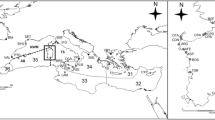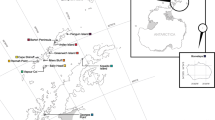Abstract
Two closely related swan species, the mute swan Cygnus olor and the whooper swan Cygnus cygnus, were formerly allopatric throughout their breeding ranges, but during the last decades a sympatric distribution has become characteristic of these species in the Baltic Sea region. The whooper swan has gradually replaced the mute swan in many suitable habitats in Lithuania and Latvia. Marked differences in the genetic population structure of both species may partially explain the dominance of the whooper swan, as genetic population divergence can be a major factor affecting inter-specific competition. A homogenous genetic population structure was defined for mute swans breeding in Lithuania, Latvia, Poland and Belarus. Breeding mute swans in this region are mostly of naturalised origin. A diverse population genetic structure characterizes whooper swans breeding in Lithuania and Latvia.
Similar content being viewed by others
References
Hardin G., Competitive exclusion principe, Science, 1960, 131, 1292–1297
Newton I., Population limitation in birds, Academic Press, London, 1998
Groning J., Hochkirch A., Reproductive interference between animal specines, Q. Rev. Biol., 2008, 83, 257–282
Qvarnstrom A., Wiley C., Svedin N., Vallin N., Life-history divergence facilitates regional coexistence of competing Ficedula flycatchers, Ecology, 2009, 90, 1948–1957
Altukhov J., Genetic processes in populations, Academkniga, Moscow, 2003, (in Russian)
Cramp S., Simmons K., Handbook of the birds of Europe, the Middle East, and North Africa: The birds of the Western Palearctic, Oxford Oxfordshire, Oxford University Press, 1977
Boiko D., Kampe-Persson H., Breeding whooper swans in Latvia, 1973–2009, Wildfowl, 2010, 60, 167–177
Kampe-Persson H., Boiko D., Occurrence of swan hybrids around the Baltic Sea — an outcome of range expansion?, Ornis Svecica, 2011, 21, 45–54
Ottosson U., Ottvall R., Elmberg J., Green M., Gustafsson R., Haas F., et al., Birds in Sweden — numbers and distribution [Fåglarna i Sverige — antal och utbredning], Swedish Ornithological Society, 2012, (in Swedish)
Väisänen R.A., Hario M., Saurola P., Population estimates of Finnish birds, In: Valkama J., Vepsäläinen V. & Lehikoinen A., (Eds.), The Third Finnish Breeding Bird Atlas, Finnish Museum of Natural History & Ministry of Environment, Helsinki, 2011
Priednieks J., Strazds M., Strazds A., Petrins A., Latvian breeding bird atlas 1980–1984, Zinatne, Riga, 1989
Tomialojc L., The birds of Poland: Their distribution and abundance, Warsaw, Poland, 1990
Grell M., Heldbjerg H., Rasmussen B., Stabell M., Tofft J., Vikstrom T., Rare and threatened breeding birds in Denmark, 1998–2003, Dansk Ornitologisk Forenings Tidsskrift, 2004, 98, 45–100
Bauer H., Woog F., Non-native and naturalised bird species (neozoa) in Germany, Part I: occurrence, population size and status, Vogelwarte, 2008, 46, 157–194, (in German)
Szinai P., Whooper Swan Cygnus cygnus, In: Csorgo T., Karcza Z., Halmos G., Magyar G., Gyuracz J., Szep T., Bankovics A. et al. (Eds.). Hungarian bird migration atlas, Kossuth Kiado, Budapest, 2009, (in Hungarian)
Boiko D., Whooper swan Cygnus cygnus in Latvia — its breeding population, wintering, moulting and dispersial geography, PhD thesis, Daugavpils University, Daugavpils, Latvia, 2012
Mineev Y., Mineev O., Birds of the Malozemelskaya tundra and of the Pechora River delta, Nauka, St. Peterburg, 2009, (in Russian)
Svazas S., Minnev Y., Minnev O., Morkunas J., The status of the whooper swan Cygnus cygnus population in Northern and Central Europe, In: Proceedings of the 8th Conference of the European Ornithologists Union (27–30 August 2011, Riga, Latvia), Latvian Ornithological Society, 2011, 374
Malchevsky A., Pukinsky Y., Birds of Leningrad region and adjacent territories (Vol. 1), Leningrad University Press, Leningrad, 1983 (in Russian)
Renno O., Estonian breeding bird atlas, Valgus, Tallinn, 1993
Nikiforov M., Kozulin A., Gritschik V., Tishechkin A., Birds of Belarus on the edge of the 21st century, Korovel Press, Minsk, 1997, (in Russian)
Ivanauskas T., Birds of Lithuania: Anatidae, Vol. 2, State Publishers of Scientific Literature, Vilnius, 1959, (in Lithuanian)
Kear J., Ducks, geese and swans (bird families in the world), Oxford University Press, Oxford, UK, 2005
Svazas S., Possible impacts of climatic conditions on changes in numbers and distribution of certain breeding and staging wildfowl species in Lithuania, Acta Zoolog. Lituanica, 2001, 11, 163–182
Svazas S., Zalakevicius M., Mineev Y., Mineev O., Recent changes in diversity of breeding bird species in Central and Northern Europe as indicators of the global change, In: Proceedings of the 2nd Conference, Bird Migration and Global Change (17–20 March 2010, Algeciras, Spain), Fundacion Migres, Algeciras, 2010, 23
Taczanowski W., Birds of the country, Vol. 1., Krakow, Poland, 1882 (in Polish)
Valius M., Lithuanian waterfowl, Mokslas, Vilnius, 1960 (in Lithuanian)
Valius M., Waterbirds of Lithuania and their ecology, Raide, Vilnius, 1980 (in Lithuanian)
Nedzinskas V., Swans in Lithuania, In: Valius M. (Ed.), Lithuanian waterbirds and their ecology, Mokslas, Vilnius, 1980, (in Lithuanian)
Logminas V., (Ed.), Fauna of Lithuania: Birds, Vol. 1., Mokslas, Vilnius, 1990, (in Lithuanian)
Svazas S., Stanevicius V., Cepulis M., The status, numbers and distribution of swans and geese in Lithuania, Acta Zoolog. Lituanica, 1997, 6, 66–79
Svazas S., Stanevicius V., Cepulis M., Inventory of important staging areas for waterfowl in Lithuania, Acta Zoolog. Lituanica, 1998, 8, 163–170
Svazas S., Kozulin A., Waterbirds of large fishponds of Belarus and Lithuania, OMPO and Institute of Ecology publishers, Vilnius, 2002
Kurlavicius P., Lithuanian breeding bird atlas, Lutute, Kaunas, 2006, (in Lithuanian)
Garrett P., Krista L., Pedersoli W., Spano J., Kemppainen R., Techniques for venous blood sampling from the white Pekin duck, Avian Dis., 1987, 31, 358–364
Kashmiri A.L., Differences in hemoglobin and packed cell volume in blood collected from different sites in Japanese quail Coturnix japonica, Int. J. Poult. Sci., 2010, 9, 828–830
Inman R.L., Scribner K.T., Prince H.H., Warrillow J.A., Luukkonen D.R., Padding P.I., A novel method for Canada goose harvest derivation using genetic analysis of tail feathers, Wild. Soc. Bull., 2003, 31, 1126–1131
Aljanabi S.M., Martinez I., Universal and rapid saltextraction of high quality genomic DNA for PCRbased techniques, Nucleic Acids Res., 1997, 25, 4692–4693
Rozen S., Skaletsky H.J., Primer3 on the www for general users and for biologist programmers, In: Krawetz S., Misener S., (Eds.), Bioinformatics Methods and Protocols: Methods in Molecular Biology, Humana Press, Totowa, 2000
Jiang F., Miao Y., Liang W., Ye H., Liu H., Liu B., The complete mitochondrial genomes of the whistling duck (Dendrocygna javanica) and black swan (Cygnus atratus): dating evolutionary divergence in Galloanserae, Mol. Biol. Rep., 2010, 37, 3001–3015
Donne-Gousse C., Laudet V., Hanni C., A molecular phylogeny of Anseriformes based on mitochondrial DNA analysis, Mol. Phylogenet. Evol., 2002, 23, 339–356
Saitou N., Nei M., The neighbor-joining method: a new method for reconstructing phylogenetic trees, Mol. Biol. Evol., 1987, 4, 406–425
Lipsbergs J., Whooper swan, In Vıksne J. (Ed.), Birds of Latvia, Zinatne, Riga, 1983 (in Russian)
Oyler-McCance S.J., Ransler F.A., Berkman L.K., Quinn T.W., A rangewide population genetic study of trumpeter swans, Conserv. Genet., 2007, 8, 1339–1353
Boiko D., Kampe-Persson H., Winter distribution of whooper swans Cygnus cygnus cygnets bred in Latvia, 2004–2008, Wildfowl, 2011, 61, 74–89
Tubelyte V., Svazas S., Sruoga A., Butkauskas D., Paulauskas A., Baublys V., et al., Genetic diversity of tufted ducks Aythya fuligula in Eastern Europe, Cent. Eur. J. Biol., 2011, 6, 1044–1053
Hailer F., Helander B., Folkestad A.O., Ganusevich S.A., Garstad S., et al. Phylogeography of the white-tailed eagle, a generalist with large dispersal capacity, J. Biogeogr., 2007, 34, 1193–1206
Spellman G.M., Riddle B., Klicka J., Phylogeography of the Mountain Chickadee (Poecile gambeli): diversification, introgression, and expansion in response to Quaternary climate change, Mol. Ecol., 2007, 16, 1055–68
Hefti-Gautschi B., Pfunder M., Jenni L., Keller V., Ellegren H., Identification of conservation units in the European Mergus merganser based on nuclear and mitochondrial DNA markers, Conserv. Genet., 2009, 10, 87–99
Smith B.T., Escalante P., Hernández Baños B.E, Navarro-Sigüenza A.G., Rohwer S., Klicka J., The role of historical and contemporary processes on phylogeographic structure and genetic diversity in the Northern cardinal, Cardinalis cardinalis, BMC Evol. Biol., 2011, 11, 136
Birkhead M., Bacon J., Walter P., Factors affecting the breeding success of the mute swan Cygnus olor, J. Anim. Ecol., 1983, 52, 727–741
Brazil M., The Whooper Swan, T. & A.D.Poyser, London, UK, 2003
Dementiev G., Gladkov N., (Eds.), Birds of the Soviet Union, Vol. 4., Nauka, Moscow, 1952, (in Russian)
Arvidsson B., Distribution and population size of whooper swan Cygnus cygnus in Sweden, Vår Fågelvärld, 1987, 46, 248–255
Nilsson L., The whooper swan Cygnus cygnus [Sångsvan Cygnus cygnus], In: Ekberg B., Nilsson L. (Eds.), Birds of Skane province, Signum, Lund, 1994, (in Swedish)
Bianki V., Swans and geese in Murmansk Region and northern Karelia, In: Proceedings of the Symposium on the mapping of waterfowl distributions, migrations and habitats (11–15 November 1976, Alushta, USSR), Moscow University Press, 1981, 225–231 (in Russian).
Haapanen A., Helminen M., Suomalainen H., The summer behaviour and habitat use of the whooper swan Cygnus cygnus, Finnish Game Research, 1977, 36, 49–81
Rees E., Einarsson O., Laubeck B., Whooper Swan, BWP Update, 1997, 1, 27–35
Nilsson L., Andersson O., Gustafsson R., Svensson M., Increase and changes in distribution of breeding whooper swans Cygnus cygnus in northern Sweden from 1972–75 to 1997, Wildfowl, 1998, 49, 6–17
Luigujoe L., Kuresoo A., Leivits A., Numbers and distribution of whooper swans breeding, wintering and on migration in Estonia, 1990–2000, Waterbirds, 2002, 25, 61–66
Endler J.A., Natural selection in the wild, Princeton University Press, Princeton, NJ, 1986
Reed D.H., Frankham R., Correlation between fitness and genetic diversity, Conserv. Biol., 2003, 17, 230–237
Facon B., Genton B.J., Shykoff J., Jarne P., Estoup A., David P., A general ecoevolutionary framework for understanding bioinvasions, Trends Ecol. Evol, 2006, 21, 130–135
Beltman J., Metz J., Speciation: more likely through a genetic or through a learned habitat preference?, Proc. Roy. Soc, B. Biol. Sci., 2005, 272, 1455–1463
Author information
Authors and Affiliations
Corresponding author
About this article
Cite this article
Butkauskas, D., Švažas, S., Tubelytė, V. et al. Coexistence and population genetic structure of the whooper swan Cygnus cygnus and mute swan Cygnus olor in Lithuania and Latvia. cent.eur.j.biol. 7, 886–894 (2012). https://doi.org/10.2478/s11535-012-0065-9
Received:
Accepted:
Published:
Issue Date:
DOI: https://doi.org/10.2478/s11535-012-0065-9




